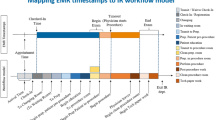Abstract
Long waiting time to appointment may be a worry for pregnant women, particularly those who need perinatology consultation since it could increase anxiety and, in a worst case scenario, lead to an increase in fetal, infant, and maternal mortality. Treatment costs may also increase since pregnant women with diverse pathologies can develop more severe complications. As a step towards improving this process, we propose a methodological approach to reduce the appointment lead-time in outpatient gynecobstetrics departments. This framework involves combining the Six Sigma method to identify defects in the appointment scheduling process with a discrete-event simulation (DES) to evaluate the potential success of removing such defects in simulation before we resort to changing the real-world healthcare system. To do these, we initially characterize the gynecobstetrics department using a SIPOC diagram. Then, six sigma performance metrics are calculated to evaluate how well the department meets the government target in relation to the appointment lead-time. Afterwards, a cause-and-effect analysis is undertaken to identify potential causes of appointment lead-time variation. These causes are later validated through ANOVA, regression analysis, and DES. Improvement scenarios are next designed and pretested through computer simulation models. Finally, control plans are deployed to maintain the results achieved through the implementation of the DES-Six sigma approach. The aforementioned framework was validated in a public gynecobstetrics outpatient department. The results revealed that mean waiting time decreased from 6.9 days to 4.1 days while variance passed from 2.46 days2 to 1.53 days2.
Access this chapter
Tax calculation will be finalised at checkout
Purchases are for personal use only
Similar content being viewed by others
References
Gunal, M., Pidd, M.: Discrete event simulation for performance modelling in health care: a review of the literature. J. Simul. 4(1), 42–51 (2010)
Jamjoom, A., Abdullah, M., Abulkhair, M., Alghamdi, T., Mogbil, A.: Improving outpatient waiting time using simulation approach. In: UKSim-AMSS 8th European Modelling Symposium, Pisa, Italy, pp. 117–125. IEEE (2014)
Nuñez-Perez, N., Ortíz-Barrios, M., McClean, S., Salas-Navarro, K., Jimenez-Delgado, G., Castillo-Zea, A.: Discrete-event simulation to reduce waiting time in accident and emergency departments: a case study in a district general clinic. In: Ochoa, Sergio F., Singh, P., Bravo, J. (eds.) UCAmI 2017. LNCS, vol. 10586, pp. 352–363. Springer, Cham (2017). https://doi.org/10.1007/978-3-319-67585-5_37
Ortiz-Barrios, M., Lopez-Meza, P., McClean, S., Polifroni-Avendaño, G.: Discrete-event simulation for performance evaluation and improvement of gynecology outpatient departments: a case study in the public sector. In: Duffy, Vincent G. (ed.) HCII 2019. LNCS, vol. 11582, pp. 101–112. Springer, Cham (2019). https://doi.org/10.1007/978-3-030-22219-2_8
Ahmed, A., Page, J., Olsen, J.: Enhancing Six Sigma methodology using simulation techniques: literature review and implications for future research. Int. J. Lean Six Sigma 11(1), 211–232 (2019)
DelliFraine, J.L., Langabeer, J.R., Nembhard, I.M.: Assessing the evidence of Six Sigma and Lean in the health care industry. Qual. Manage. Healthc. 19(3), 211–225 (2010)
Henrique, D.B., Godinho Filho, M.: A systematic literature review of empirical research in Lean and Six Sigma in healthcare. Total Qual. Manage. Bus. Excellence 31(3–4), 429–449 (2020)
Lippi, G., Plebani, M.: A Six-Sigma approach for comparing diagnostic errors in healthcare—where does laboratory medicine stand? Ann. Transl. Med. 6(10), 1–3 (2018)
Montella, E., et al.: The application of Lean Six Sigma methodology to reduce the risk of healthcare–associated infections in surgery departments. J. Eval. Clin. Pract. 23(3), 530–539 (2017)
Hynes, J.P., et al.: Use of Lean Six Sigma methodology shows reduction of inpatient waiting time for peripherally inserted central catheter placement. Clin. Radiol. 74(9), 733.e5–733.e9 (2019)
Chang, D.S., Leu, J.D., Wang, W.S., Chen, Y.C.: Improving waiting time for surgical rooms using workflow and the six-sigma method. Total Qual. Manage. Bus. Excellence 31, 1–18 (2018)
Aeenparast, A., Tabibi, S.J., Shahanaghi, K., Aryanejhad, M.B.: Reducing outpatient waiting time: a simulation modeling approach. Iran. Red Crescent Med. J. 15(9), 865–869 (2013)
Bean, D.M., Taylor, P., Dobson, R.J.B.: A patient flow simulator for healthcare management education. BMJ Simul. Technol. Enhanced Learn. 5(1), 46–48 (2019)
Ortíz-Barrios, M., Jimenez-Delgado, G., De Avila-Villalobos, J.: A computer simulation approach to reduce appointment lead-time in outpatient perinatology departments: a case study in a maternal-child hospital. In: Siuly, S., et al. (eds.) HIS 2017. LNCS, vol. 10594, pp. 32–39. Springer, Cham (2017). https://doi.org/10.1007/978-3-319-69182-4_4
Ortiz Barrios, M., Felizzola Jiménez, H.: Reduction of average lead time in outpatient service of obstetrics through six sigma methodology. In: Bravo, J., Hervás, R., Villarreal, V. (eds.) AmIHEALTH 2015. LNCS, vol. 9456, pp. 293–302. Springer, Cham (2015). https://doi.org/10.1007/978-3-319-26508-7_29
Ortiz Barrios, M.A., Escorcia Caballero, J., Sánchez Sánchez, F.: A methodology for the creation of integrated service networks in outpatient internal medicine. In: Bravo, J., Hervás, R., Villarreal, V. (eds.) AmIHEALTH 2015. LNCS, vol. 9456, pp. 247–257. Springer, Cham (2015). https://doi.org/10.1007/978-3-319-26508-7_24
Izquierdo, N.V., Lezama, O.B.P., Dorta, R.G., Viloria, A., Deras, I., Hernández-Fernández, L.: Fuzzy logic applied to the performance evaluation. Honduran coffee sector case. In: Tan, Y., Shi, Y., Tang, Q. (eds.) ICSI 2018. LNCS, vol. 10942, pp. 164–173. Springer, Cham (2018). https://doi.org/10.1007/978-3-319-93818-9_16
Author information
Authors and Affiliations
Corresponding author
Editor information
Editors and Affiliations
Rights and permissions
Copyright information
© 2020 Springer Nature Switzerland AG
About this paper
Cite this paper
Ortíz-Barrios, M., McClean, S., Jiménez-Delgado, G., Martínez-Sierra, D.E. (2020). Integrating Lean Six Sigma and Discrete-Event Simulation for Shortening the Appointment Lead-Time in Gynecobstetrics Departments: A Case Study. In: Duffy, V. (eds) Digital Human Modeling and Applications in Health, Safety, Ergonomics and Risk Management. Human Communication, Organization and Work. HCII 2020. Lecture Notes in Computer Science(), vol 12199. Springer, Cham. https://doi.org/10.1007/978-3-030-49907-5_27
Download citation
DOI: https://doi.org/10.1007/978-3-030-49907-5_27
Published:
Publisher Name: Springer, Cham
Print ISBN: 978-3-030-49906-8
Online ISBN: 978-3-030-49907-5
eBook Packages: Computer ScienceComputer Science (R0)




